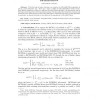Free Online Productivity Tools
i2Speak
i2Symbol
i2OCR
iTex2Img
iWeb2Print
iWeb2Shot
i2Type
iPdf2Split
iPdf2Merge
i2Bopomofo
i2Arabic
i2Style
i2Image
i2PDF
iLatex2Rtf
Sci2ools
41
Voted
CORR
2010
Springer
2010
Springer
ML(n)BiCGStab: Reformulation, Analysis and Implementation
With the help of index functions, we re-derive the ML(n)BiCGStab algorithm in [35] in a more systematic way. There are n ways to define the ML(n)BiCGStab residual vector. Each different definition will lead to a different ML(n)BiCGStab algorithm. We demonstrate this by deriving a second algorithm which requires less storage. We also analyze the breakdown situations and summarize some useful properties about ML(n)BiCGStab. Implementation issues are also addressed. In particular, we discuss in details on the choices of the parameters in ML(n)BiCGStab. Key words. CGS, BiCGStab, ML(n)BiCGStab, multiple starting Lanczos, Krylov subspace, iterative methods, linear systems AMS subject classifications. Primary, 65F10, 65F15; Secondary, 65F25, 65F30.
Related Content
| Added | 09 Dec 2010 |
| Updated | 09 Dec 2010 |
| Type | Journal |
| Year | 2010 |
| Where | CORR |
| Authors | Man-Chung Yeung |
Comments (0)

